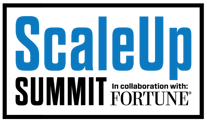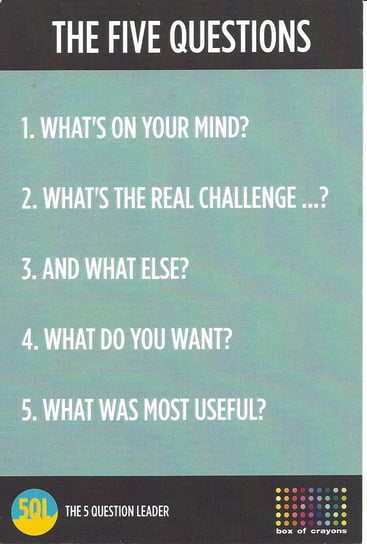 This blog comes with a warning: If you believe you can read this and get the full measure of its impact, you’re WRONG!
This blog comes with a warning: If you believe you can read this and get the full measure of its impact, you’re WRONG!
Michael-Bungay-Stainer, author of The Coaching Habit, provided impactful knowledge and exercises to help our audience delegate, empower, and make each of us a better leader.
Confession: I started reading Michael-Bungay-Stainer - The Coaching Habit: Say Less, Ask More & Change the Way You Lead Forever, and even published a blog on a portion of its contents in How to Build A Habit. When I got past the first chapter on habits in the book and proceeded through the next several chapters, I thought, I know all this. I’ve been coaching for nearly 20 years. Been there done that.
What I failed to realize is how powerful the Five Questions Michael-Bungay-Stainer  shares in the book are in practice. Stainer is Australian, and his message and exercises delivered a powerful impact on our audience at the Scale-Up Summit in San Antonio.
shares in the book are in practice. Stainer is Australian, and his message and exercises delivered a powerful impact on our audience at the Scale-Up Summit in San Antonio.
Fundamental Behavior Change
Michael-Bungay-Stainer simple, yet difficult insight to follow for leading and managing (Coaching) is this:
- Stay curious a bit longer
- Rush to action and advice a little more slowly
These two simple behaviors, when followed, deliver more benefits than you can ever imagine.
Put these together with three coaching principles:
- BE LAZY: You’re working too hard. Stop jumping in to fix things, solve the problem, give the answer. Help your people do the work. (The exercise we did with a partner at our table proved how impactful this can be.)
- BE CURIOUS: You love to give advice. Slow down. Stay curious a bit longer
- BE OFTEN: Every interaction you have with everyone (your team, your peers, your boss, your customers) can be more coach-like.
Simple right?
Most of us fail right out of the gate with #1. Indeed, most of us as managers and leaders often feel like we need to do something in order to fulfill our role, our “title.” The truth of course is unless you wish to stay in your role forever, you need to empower your people. Get them to make decisions, solve problems on their own, so you can do the more important and impact things you were hired to do.
FIVE QUESTIONS
What I and my partners at our table discovered when we went through the Five Questions is, “It’s Hard to not give feedback.”
It creates a sense of anxiety in you. You must recognize in your role to empower them, you’re in the land of the question, and they’re in the land of the answers. Give up your own power and empower them. (This my friends is exactly what servant leadership looks like.)
KEY: When’s the best time to give advice? The longer you can wait to give advice, the better! I’ll share why in a minute.
When your people come to you with a question, instead of answering, respond: “Great question, before I give you answers, and I will give you one, I’m going to ask you a few questions.”
 WHAT’S ON YOUR MIND? Stainer calls this the Kickstart Question. It’s how to start a conversation more quickly so you get to the conversation that matters. Most of us immediately think I’m going to add value, we think I can help her/him. Don’t! Help others become more confident. You Need to change your behavior. If one-on-ones are tedious. Experiment with this question. You may find it’s well worth experimenting with.
WHAT’S ON YOUR MIND? Stainer calls this the Kickstart Question. It’s how to start a conversation more quickly so you get to the conversation that matters. Most of us immediately think I’m going to add value, we think I can help her/him. Don’t! Help others become more confident. You Need to change your behavior. If one-on-ones are tedious. Experiment with this question. You may find it’s well worth experimenting with.- WHAT’S THE REAL CHALLENGE HERE FOR YOU? This is the focus Question. For those of you familiar with The One Thing Focus Question, I don’t need to tell you how important this is. Stainer insists it will allow you to spend time on the real issue, not the first issue. (Most of us are investing great resources in question/issue/problem, and it’s the wrong challenge) Stainer emphasized the importance of including, “for you.” This swings it away from the problem to them. It works on the person who is working on the challenge. Invests in them.
- AND WHAT ELSE? (AWE) Stainer believes this is the best coaching question in the world! Why? Their first answer is rarely their only answer, and it’s rarely the best answer. (Perhaps the best thing about this question is it’s a Self-Management Tool - to keep you curious) What you discover when you’re on the other side is how good it feels when you’re given the time to respond. Ask the AWE question several times. The AWE is different the 2nd time than the first one. In most cases, we never wait to get to the real challenge or question. Is your advice as good as you thought it was after the first real challenge? When you get to what the real challenge is, you can say get out of my office, we’re done here, they know what to do. Stainer notes that in most cases when they figure out what the challenge is they’ll leave. They’ll have figured out how to solve the problem themselves. (This makes your team self-sufficient, it helps you discover coaching can serve you.)
- WHAT DO YOU WANT? (WHAT ELSE DO YOU WANT) Stainer calls this the Foundation Question. It’s really the heart of the conversation. Ask them this question. Ask yourself this question.
- WHAT WAS MOST USEFUL OR VALUABLE TO YOU? Stainer this finishes your conversation more strongly. It’s the final bookend question.
What’s the real value of this?
When you do this exercise you learn to be a more effective leader.(I did these questions in a monthly coaching meeting with one of my customers. Even though we only had time for the first two, this leadership team immediately could sense and feel the impact. They quickly realized how frequently they wanted to jump in to offer advice and solve a problem.)
Why? Stainer shared this: We need to be more effective teachers:
People do not learn when you tell them stuff.
They don’t learn much when they do stuff.
People learn stuff when they have time to reflect!
WARNING: You won’t realize the full impact of these Five Questions until you practice them with someone else!
For coaching ideas and help like this, to Develop a Winning Habit, contact dwick@positioningsystems.com
NEXT BLOG – CONSCIOUS CAPITALISM
“First Who, Then What,” ~ Jim Collins in Good to Great
“The business of business is people, yesterday, today, tomorrow.” ~ Herb Kelleher, Southwest Airlines
Next blog: Raj Sisodia, co-author of Conscious Capitalism, shared why business needs to change. Why does the 16% consumer confidence in big business, cynicism, and distrust, have high business and societal costs?






.jpeg?width=150&height=135&name=Hand%20with%20marker%20writing%20the%20question%20Whats%20Next_%20(1).jpeg)

